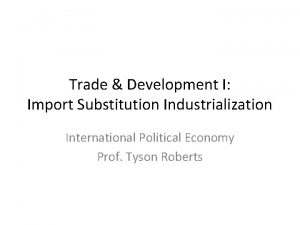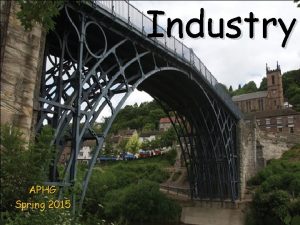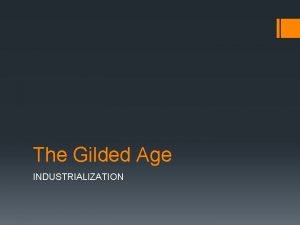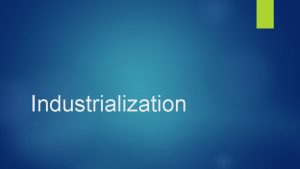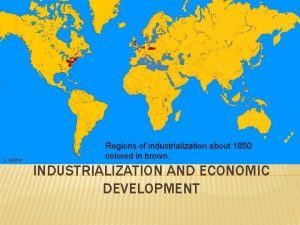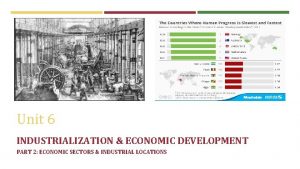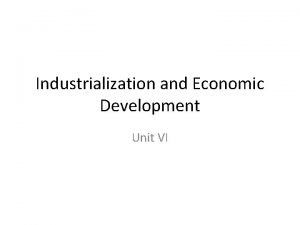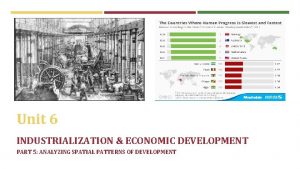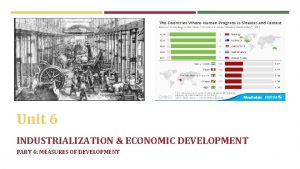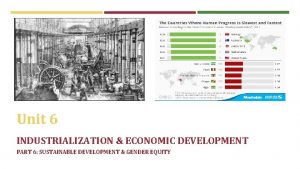Unit 6 INDUSTRIALIZATION ECONOMIC DEVELOPMENT PART 3 ECONOMIC













- Slides: 13

Unit 6 INDUSTRIALIZATION & ECONOMIC DEVELOPMENT PART 3: ECONOMIC INTERDEPENDENCE

ESSENTIAL QUESTION How has growing economic interdependence changed spatial relationships among people in the world?

ENDURING UNDERSTANDINGS (6. A-D) � By the end of this unit, you will understand that � The Industrial Revolution, as it diffused from its hearth, facilitated improvements in standards of living. � Measures of development are used to understand patterns of social and economic differences at a variety of scales. � Development is a process that varies across space and time. � Sustainable development is a strategy to address resource depletion and environmental degradation.

LEARNING OBJECTIVE (6. C. 1) �By the end of this section, you will be able to analyze the causes and consequences of international trade and growing interdependence in the world economy. �Complementarity and comparative advantage establish the basis for trade. �International trade and trading blocs (e. g. , the European Union and NAFTA) have become more important as a result of globalization. �Geographies of interdependence in the world economy include global financial crisis, the shift in manufacturing to newly industrialized countries, imbalances in consumption patterns, and the roles of women in the labor force.

TRADE & INTERDEPENDENCE � Complementarity & Comparative Advantage � International Trade & Trading Blocs � Manufacturing in NICs � Consumption Patterns � Impact of Global Financial Crisis

10 -2 -2 | PAUSE - INTERACT - COMPARE Steps: 1. Underline or highlight key terms that we went over. 1. Compare your notes with your elbow partner. Write any notes that you may have missed into your notes.

LEARNING OBJECTIVE (6. C. 2) �By the end of this section, you will be able to explain how economic restructuring and deindustrializationare transforming the contemporary economic landscape. �Outsourcing and economic restructuring have led to a decline in jobs in manufacturing regions and to the relocation of a significant segment of the workforce to other areas. �In countries outside of the core, the diffusion of industry has resulted in the emergence of the international division of labor and manufacturing zones (e. g. , maquiladoras, special economic zones, free trade zones). �The contemporary economic landscape has been transformed by the emergence of service sectors, high technology industries, and growth poles (e. g. , Silicon Valley and the Research Triangle in the U. S. ). �Government initiatives at all scales may help promote economic development.

CHANGING GLOBAL ECONOMY � Outsourcing & Economic Restructuring � Transnationals & Export Processing Zones � Ethics & Societal Changes

10 -2 -2 | PAUSE - INTERACT - COMPARE Steps: 1. Underline or highlight key terms that we went over. 1. Compare your notes with your elbow partner. Write any notes that you may have missed into your notes.

POST-INDUSTRIAL LANDSCAPE � Fate of Brownfields � Corporate Parks & Campuses � Technopoles � Government Development Initiatives

COMPARING CORPORATE & INDUSTRIAL PARKS Attribute Corporate Parks Industrial Parks Size of Tract Large Location Edges of communities where land is inexpensive and near residential areas. Buildings Low-rise office buildings Large factories or warehouses Roads Designed for cars: small and can be curvy Designed for trucks: wide and straight Grounds Park-like: spacious lawns, sidewalks, walking trails, and sitting areas. Very functional

GOVERNMENT EFFORTS TO PROMOTE ECONOMIC GROWTH TYPE OF INCENTIVE Tax Breaks WHAT BUSINESSES RECEIVE - A tax holiday (a temporary exemption from some taxes). A tax break for money invested in research and development. Loans - Forgivable loans. Money to borrow at below-normal interest rates. Direct Assistance - The use of land or buildings free of charge. Infrastructure such as roads and sewers paid for by the government. A subsidy for each full-time job created. - Legislation that weakens unions. Legislation that reduces environmental rules. Changes in Regulations

INTERACT & SUMMARIZE Steps: 1. Underline or highlight main ideas or key concepts in your notes. 2. Write a summary reflection answering the EQ: - How has growing interdependence changed spatial relationships among people in the world?
 Economic growth vs economic development
Economic growth vs economic development Conclusion of growth and development
Conclusion of growth and development Unit 6 review questions
Unit 6 review questions Part whole model subtraction
Part whole model subtraction Part to part ratio definition
Part to part ratio definition Brainpop ratios
Brainpop ratios What is technical description
What is technical description Bar prats
Bar prats The part of a shadow surrounding the darkest part
The part of a shadow surrounding the darkest part 미니탭 gage r&r 해석
미니탭 gage r&r 해석 Import substitution industrialization
Import substitution industrialization Industrialization
Industrialization Duma definition ap world history
Duma definition ap world history Primary secondary tertiary aphg
Primary secondary tertiary aphg










